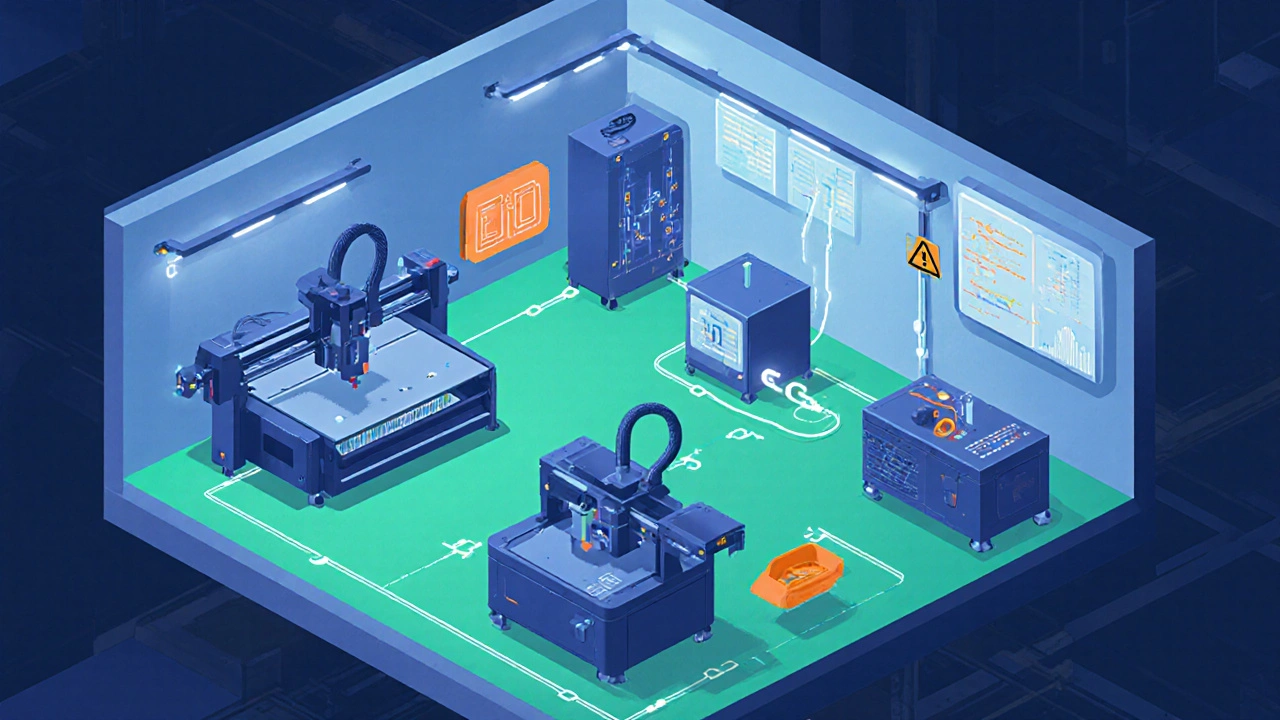
Small Manufacturing Startup Cost Calculator
Calculate estimated startup costs for your small manufacturing business based on your specific parameters.
Small manufacturing company is a business that produces tangible goods on a modest scale, usually with fewer than 50 employees and limited capital investment. These firms sit at the heart of local economies, turning raw material into everyday products while staying agile enough to pivot with market trends.
Key Characteristics You’ll Spot
First off, size matters. A small manufacturing company typically operates under a production capacity of 5,000-10,000 units per month, depending on the industry. Staff numbers hover between 5 and 40, and the facility often occupies under 5,000 square feet. Capital outlay is usually below $5million, meaning owners rely heavily on personal savings, bank loans, or government grants.
Second, ownership tends to be concentrated. Most are family‑run or owned by a single entrepreneur who wears many hats-from production manager to sales lead. This hands‑on approach creates an environment where decisions are made quickly, giving the business a competitive edge over larger, bureaucratic players.
Common Types of Small Manufacturing Companies
- Family‑owned niche producers: Think of a boutique chocolate maker in Sydney that sources local cocoa beans and sells through farmer’s markets.
- Contract manufacturers: Small firms that produce components for larger brands under a private‑label agreement.
- Specialty fabricators: Companies that laser‑cut metal parts for prototype development.
- Artisanal goods makers: Hand‑crafted furniture workshops or custom‑printed textile studios.
Legal Structure and Registration in Australia
When you register a Small and medium-sized enterprise (SME) you’ll need an Australian Business Number (ABN) and, if you operate under a company name, registration with the Australian Securities & Investments Commission (ASIC). Choosing between a sole trader, partnership, or proprietary limited (Pty Ltd) structure depends on liability preferences and tax considerations.
Compliance isn’t optional. Occupational Health and Safety (OHS) regulations, environmental standards, and the Australian Consumer Law all apply, regardless of scale. Small firms often find compliance easier because they can directly oversee each process without layers of management.

Funding Options and Government Support
Australia offers a suite of programs aimed at bolstering the small manufacturing sector. The Business Grants Hub lists the Manufacturing Modernisation Fund, which provides up to $250,000 for technology upgrades. The New Business Assistance with NEIS offers free training and a modest stipend for new entrepreneurs.
Bank loans remain a staple, especially from regional banks that understand local market dynamics. Many lenders look for a solid business plan, a clear break‑even analysis, and evidence of market demand before committing funds.
Advantages and Challenges of Going Small
Flexibility tops the advantage list. A small manufacturing company can shift production lines overnight to meet a sudden spike in demand for a seasonal product. Lower overheads also mean pricing can stay competitive. On the flip side, limited cash flow restricts bulk purchasing discounts and can make it harder to absorb sudden cost increases in raw materials. Additionally, scaling up often requires a steep learning curve-adding new equipment, hiring specialised staff, and navigating stricter regulatory thresholds.
Technology Adoption: Lean, Automation, and Industry4.0
Lean manufacturing principles-value‑stream mapping, just‑in‑time inventory, and continuous improvement-are especially effective for small firms because they minimise waste without needing complex ERP systems.
Automation doesn’t have to mean massive robotic arms. Affordable CNC routers, 3‑D printers, and tabletop laser cutters can boost output while keeping labour costs stable. Small manufacturers that integrate basic IoT sensors can monitor machine health, reduce downtime, and collect data for smarter decision‑making-a step toward Industry4.0 that’s within reach.

Step‑by‑Step Checklist to Launch Your Small Manufacturing Company
- Define your product niche and validate market demand through surveys or pilot sales.
- Draft a detailed business plan covering production workflow, cost structure, and break‑even points.
- Choose a legal structure and register your ABN and ASIC details.
- Secure funding-explore government grants, bank loans, or angel investors.
- Locate a suitable facility that meets zoning, safety, and size requirements.
- Purchase essential equipment; start with scalable tools that allow future upgrades.
- Implement lean processes and, if possible, install a basic IoT monitoring system.
- Obtain necessary certifications-ISO9001 for quality, or specific industry standards.
- Launch a targeted marketing campaign using local trade shows and online platforms.
- Monitor key performance indicators (KPIs) like unit cost, lead time, and defect rate, adjusting operations as needed.
Quick Takeaways
- Small manufacturing companies usually have under 50 staff and under $5million in capital.
- They thrive on flexibility, niche focus, and close customer relationships.
- Government grants and lean practices level the playing field against larger rivals.
- Adopting affordable automation and IoT tools can future‑proof the business.
- A clear step‑by‑step plan helps turn a workshop idea into a sustainable enterprise.
Frequently Asked Questions
What defines a small manufacturing company in Australia?
In Australia, a small manufacturing company typically employs fewer than 50 people, operates under a capital investment of $5million, and produces up to about 10,000 units per month, though exact thresholds can vary by industry.
Do I need an ISO certification to start?
ISO certification isn’t mandatory for most small manufacturers, but obtaining ISO9001 can open doors to larger contracts and demonstrates a commitment to quality.
Which government grants are most useful for a new small factory?
The Manufacturing Modernisation Fund, regional business development grants, and the New Business Assistance with NEIS program are popular choices for capital, equipment upgrades, and business training.
Can I automate production on a tight budget?
Yes. Small CNC routers, desktop 3‑D printers, and basic IoT sensors cost under $10,000 and can dramatically improve efficiency without the expense of full‑scale robotic lines.
What are the biggest risks for small manufacturers?
Cash‑flow shortages, supply‑chain disruptions, and regulatory compliance gaps are the top risks. Building a reserve fund, diversifying suppliers, and staying current on OHS and environmental rules mitigate these threats.